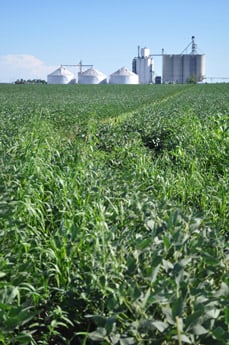According to a recent news article, the Monsanto Corporation going forward wants to be known as a “yield company.” Duh? How can this be news? Hasn’t Monsanto always been a yield company?
Strange as it might seem, the answer is no. Monsanto built a thriving seed and pesticide business without focusing much on yield. Its wildly successful flagship product is a soybean genetically engineered to tolerate being sprayed with one herbicide rather than another. The herbicide at issue is Roundup, a Monsanto product. At the time the new crops were introduced, Roundup was regarded as a relatively benign herbicide compared to those in use. (This view of glyphosate is changing, a topic for another post.) Farmers enthusiastically embraced Roundup, in part as a safer chemical, but also because the weeds in their bean fields had never “met” the herbicide before and as a result could be controlled with low concentrations, often applied only once.
For farmers, this meant dramatically lower weed control costs, new convenience in applying herbicides, and a good feeling about no longer needing to rely on toxic herbicides. Some of the savings were eaten up in higher seed costs, but for many, many farmers, the appeal was irresistible.
The Monsanto Miracle
For Monsanto, extending their market for Roundup to soybeans and other commodity crops meant huge new markets for the company—potentially seed and chemicals for 60 or 70 million acres. And in the case of soybeans, because the seed was patented, Monsanto was able to force farmers who had traditionally saved seed to buy new seeds every year, yet another boost in sales.
Seeds, pesticides, and farmers buying seed every year—a veritable trifecta of profit.
The discovery of a resistance gene for its own popular herbicide, abetted by a newly broadened patent system, must have seemed like something of a miracle to Monsanto, but it sure wasn’t the miracle that biotechnology promised. The public was looking for higher yields with less dependence on chemicals.
Even before resistance develops, simply replacing one herbicide with another is a paltry reduction in the chemical footprint of agriculture. After resistance develops, as it happening now, the benefit is transformed into a disaster as pesticide use skyrockets.
(And yes, I realize that the Bt crops do better on both pesticide reduction and yield, which we will discuss in another post, but herbicide-tolerant beans are by far the premier product of biotechnology.)
Herbicide-tolerant crops and yield
And what about yield? My colleague, Doug Gurian-Sherman, demonstrated in a carefully done report that although yields of the engineered soybeans have increased since the introduction of Roundup-tolerant crops, it was not due to the herbicide-tolerant trait. The yields increased primarily because of classical breeding and other agronomic processes.
Monsanto has had a hard time making this distinction between increased yields and increased yields due to biotechnology. To listen to them tell it, you might think their genetically engineered traits caused the increases in yield and could be counted on for future yield increases. One rarely hears from them about the essential role played by classical breeding, but the word is getting around.
So maybe that’s why Monsanto wants to rebrand itself as a yield company. It realizes that if the world is going to feed 3 billion more people in the next 40 years, we are going to need increases in yield and it wants to look like the indispensible technology for solving that problem. But people are beginning to figure out that from a yield standpoint, genetic engineering isn’t anything near a miracle technology. The indispensible technologies are classical breeding and agroecology.
This is not to say that genetic engineering may not contribute to the solution. It may. But we need to keep our eyes on the prize… the technologies proven to work to increase yield and reduce chemical inputs. Classical breeding and agroecology may not seem glitzy, but for yield, they perform the real miracles.

